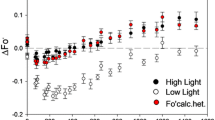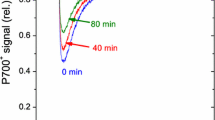Abstract
Measurements are reported on μs delayed light emission, following a single 10 ns excitation flash, in Alaska pea thylakoids treated with hydroxylamine (NH2OH) or with silicomolybdate.
-
1.
In thylakoids treated with 2 mM NH2OH in the light, or in the dark, the quantum yield of delayed light emission is considerably enhanced. A 10 μs lifetime component of delayed light emission is not significantly changed, whereas a 50–70 μs lifetime component is increased. MnCl2 and diphenylcarbazide are unable to reverse the above effects of NH2OH treatment. Thus Mn2+ and diphenylcarbazide must not donate electrons directly to reaction center II but on the oxygen-evolution side of the NH2OH block.
-
2.
When the closed form of photosystem II reaction centers (P680Q-), where P680 is the reaction center chlorophyll and Q is a ‘stable’ electron acceptor, is generated by preillumination of NH2OH-treated thylakoids with diuron present, the μs delayed light emission is inhibited, but a low level residual delayed light emission remains. Possible origins of this emission are discussed. It is believed that the best explanation for residual DLE is the existence of another acceptor besides Q that partakes in charge separation and rapid dissipative recombination when the reaction center is in the P680Q- state.
-
3.
The quantum yield of delayed light emission from ‘closed’ reaction centers (P680 +Q-) that have all charge stabilization reactions (i.e., flow of electrons to P680 + and out of Q-) blocked by NH2OH treatment and addition of diuron is 1.1×10-3 for components measured in a range from 6 to 400 μs and extrapolated to zero time.
-
4.
The addition of silicomolybdate, which accepts electron from Q-, causes delayed light emission in the μs range to be greatly inhibited.
Similar content being viewed by others
Abbreviations
- DCMU:
-
diuron=3-(3,4-dichlorophenyl) 1,1 dimethylurea
- DLE:
-
delayed light emission
- DPC:
-
diphenylcarbazide
References
ArnoldW (1976) Bath of electrons in photosynthesis. Proc Natl Acad Sci USA 73: 4502–4505.
BabcockGT and SauerK (1975) Two electron donation sites for exogenous reductants in chloroplast photosystem II. Biochem Biophys Acta 396: 48–62.
BennounP (1970) Réoxydation du quencher de fluorescence ‘Q’ en présence de DCMU. Biochim Biophys Acta 216: 357–363.
ButlerWL (1972) The relationship between P-680 and C-550. Biophysical J 12: 851–857.
CheniaeGM and MartinIF (1971) Effects of hydroxylamine on photosystem II. I. Factor affecting the decay of O2 evolution. Plant Physiol 47: 568–575.
CramerWA and ButlerWL (1969) Potentiometric titration of the fluorescence yield of spinach chloroplasts. Biochim Biophys Acta 172: 503–510.
DenHaanGA et al (1974) Fluorescence yield kinetics in the microsecond range in Chlorella pyrenoidosa and spinach chloroplasts in the presence of hydroxylamine. Biochim Biophys Acta 368: 409–421.
DenHaanGA et al (1976) Correlation between flash-induced oxygen evolution and fluorescence yield kinetics in the 0 to 16 μs range in Chlorella pyrenoidosa during incubation with hydroxylamine. Biochim Biophys Acta 430: 265–281.
DuysensLNM and SweersHE (1963) Mechanism of two photochemical reactions in algae as studied by fluorescence. In Japan Society of Plant Physiology, eds. Studies in Microalgae and Photosynthetic Bacteria, pp 353–372. Tokyo, Univ. of Tokyo Press.
DuysensLNM et al (1974) Rapid reactions of photosystem II as studied by the kineties of the fluorescence and luminescence of chlorophyll a in Chlorella pyrenoidosa. In AvronM, ed. Proceedings of the Third International Congress on Photosynthesis, pp 1–12. The Netherlands, Elsevier Scientific Publishing Company.
EckertHJ and RengerG (1980) Photochemistry of the reaction centers of system II under repetitive flash group excitation in isolated chloroplasts. Photochem Photobiol 31: 501–511.
FloydRA et al (1971) Low temperature photo-induced reactions in green leaves and chloroplasts. Biochim Biophys Acta 226: 103–112.
GiaquintaRT et al (1974) Photophesphorylation not coupled to DCMU-insensitive photosystem II oxygen evolution. Biochem Biophys Res Commun 59: 985–991.
GlaserM et al (1976) Indireet evidence for a very fast recovery kinetics of chlorophyll-all in spinach chloroplasts. Z Naturforsch 31c: 712–721.
Govindjee and JursinicP (1979) Photosynthesis and fast changes in light emission by green plants. In SmithKC, ed. Photochemical and Photobiological Reviews, Vol 4, pp. 125–205. New York, Plenum Press.
HavemanJ and LavorelJ (1975) Identification of the 120 μs phase in the decay of delayed fluorescence in spinach chloroplasts and subchloroplast particles as the intrinsic back reaction. The dependence of the level of this phase on the thylakoid internal pH. Biochim Biophys Acta 408: 269–283.
JoliotP and JoliotA (1972) Studies on the quenching properties of photosystem II electron acceptor. In FortiG et al. eds. Proceedings of the Second International Congress on Photosynthesis Research, pp. 26–38. The Hague, Junk.
JoliotP and JoliotA (1981) A photosystem II electron acceptor which is not a plastoquinone. FEBS Lett 134: 155–158.
JursinicP and Govindjec (1977) The rise in chlorophyll a fluorescence yield and decay in delayed light emission in tris-washed chloroplasts in the 6–100 μs time range after an excitation flash. Biochim Biophys Acta 461: 253–267.
JursinicP et al (1976) A major site of bicarbonate effect in system II reaction evidence from ESR signal IIvf, fast fluorescence yield changes and delayed light emission. Biochim Biophys Acta 440: 322–330.
KimimuraM and KatohS (1972) Studies on electron transport associated with photosystem I. I. Functional site of plastocyanin: Inhibitory effects of HgCl2 on electron transport and plastocyanin in chloroplasts. Plant Cell Physiol 13: 287–296.
KlimovVV et al (1978) Measurement of activation energy and lifetime of fluorescence of PS II chlorophyll. Doklady Akademii Nauk SSSR 242: 1204–1207.
LatimerP et al (1957) The absolute quantum yield of fluorescence of photosynthetically active pigment. In GaffronH et al., eds. Research in Photosynthesis, pp. 107–112. New York, Wiley Interscience.
LavorelJ (1969) On a relation between fluorescence and luminescence in photosynthetic systems. Prog Photosynth. Res 2: 883–898.
LavorelJ (1973) Kinetics of luminescence in the 10-6 to 10-4 s range in Chlorella. Biochim Biophys Acta 325: 213–229.
LavorelJ (1975) Luminescence. In Govindjee, ed. Bioenergetics of photosynthesis, pp. 223–317. New York, Academic Press.
MarT and RoyG (1974) A kinetic model of the primary back reaction in photosynthesis of green plants. J. Theor Biol 48: 257–281.
MelisA and HomannPH (1976) Heterogeneity of the photochemical centers in system II of chloroplasts. Photochem Photobiol 23: 343–350.
MohantyP et al (1971) Action of hydroxylamine in the red alga Porphyridium eruentum. Biochem Biophys Acta 253: 213–221.
MohantyP et al (1980) Further characterization of a photosystem II particle isolated from spinach chloroplasts by triton treatment. Delayed light emission. Biochim Biophys Acta 545: 285–295.
RubyRH (1968) Delayed fluorescence in photosynthetic materials: Transient response to pulsed light in Chlorella. Photochem Photobiol 8: 299–308.
SchmidGH et al (1976) Effect of an antiserum to a thylakoid membrane polypeptide on the primary photoreaction of photosystem II. Z Naturforsch 31 c: 594–600.
SonneveldA et al (1979) Chlorophyll a fluorescence as a monitor of nanosecond reduction of the photooxidized primary donor P +680 of photosystem II. Biochim Biophys Acta 548: 536–551.
StacyWT et al (1971) An analysis of a triplet exciton model for the delayed light in Chlorella. Photochem Photobiol 14: 197–219.
TollinG et al (1958) Delayed light emission in green plant materials: Temperature-dependence and quantum yield Proc Natl Acad Sci USA 44: 1035–1047.
VanBestJA and DuysensLNM (1979) A one microsecond component of chlorophyll luminescence suggesting a primary acceptor of system 2 of photosynthesis different than Q. Biochim Biophys Acta 459: 187–206.
VanGorkomHJ and DonzeM (1973) Charge accumulation in the reaction center of photosystem 2. Photochem Photobiol 17: 333–342.
ZankelKL (1971) Rapid delayed luminescence from chioroplasts: Kinetic analysis of components; the relationship to the O2 evolving system. 245: 373–385.
ZilinskasBA and Govindjee (1975) Silicomolybdate and silicotungstate mediated dichlorophenyl-dimethylurea-insensitive photosystem II reaction: Electron flow, chlorophyll a fluorescence and delayed light emission changes. Biochim Biophys Acta 387: 306–319.
Author information
Authors and Affiliations
Additional information
The mention of firm names or trade products does not imply that they are endorsed or recommended by the U.S. Department of Agriculture over other firms or similar products not mentioned.
Rights and permissions
About this article
Cite this article
Jursinic, P., Govindjee Effects of hydroxylamine and silicomolybdate on the decay in delayed light emission in the 6–100 μs range after a single 10 ns flash in pea thylakoids. Photosynth Res 3, 161–177 (1982). https://doi.org/10.1007/BF00032254
Received:
Issue Date:
DOI: https://doi.org/10.1007/BF00032254




